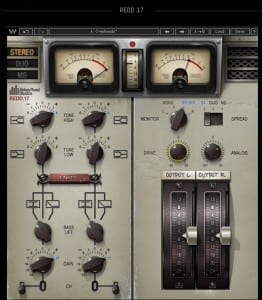Emerging Studio Technology: A Plugin by Waves Audio and Abbey Road Studios
Welcome once again to Sage Audio’s Emerging Studio Technology blog series. This semi-regular series takes a look at the latest and greatest (and sometimes not so greatest) gadgets and technologies for studios. Some of the things we cover are designed specifically for home studio recording, while other technology may fit better in our own CD mastering studio. But most of these cool products can be of use to many engineers, producers and musicians – if it’s new and related to recording or mastering studios, you’ll find it here.
Waves Audio REDD Console Plugins
The world of mixing consoles is a very wide one, and in the many decades that they have been manufactured, there have been quite a few great models, and probably many more which history has (fortunately) forgotten. However, there are a few consoles that make up a very elite club, and these boards have become as legendary as the artists that recorded on them.
We would argue that one currently is right down the street from our Nashville mastering studio at RCA Studio B, and I think just about every music industry professional would agree that the original consoles used by the Beatles, Pink Floyd and many more at what is now known as Abbey Road Studios (then known as EMI Studios) are perhaps the best known throughout the world.
Waves Audio has worked with Abbey Road to produce plugins that replicate the legendary sound of three of those consoles, the REDD.17, REDD.37 and REDD.51 (The latter two are combined into the plugin REDD.37-.51). The original consoles were developed and built by the studio's in-house Record Engineering Development Department (REDD), and Mirek Stiles, Head of Audio Products at Abbey Road, spoke of the consoles in a statement.

“Most of the original REDD consoles have been lost over time, but by using the few examples left over and studying the original schematics and design notes from the archives, I believe Waves and Abbey Road have revived an important part of musical history that will enable producers of all generations to discover and fall in love with the lost sound of REDD,” Stiles said.
Abbey Road still owns the REDD.17 console, and the REDD.37 currently is owned by Lenny Kravitz.
“Waves is proud to be working together with Abbey Road Studios to preserve the legacy of the legendary REDD consoles,” said Waves CEO and co-founder Gilad Keren in the statement. “The REDD consoles were used to help create so much timeless music in the past, and by making their sound available via plugins, we hope to contribute to the creation of timeless music that will be made in the future.”
Features vary depending on the model, but they are built to capture the 1960s British rock sound. The following is the Waves features list for the plugins:
Amp Type determines the type of amplifier. (REDD .37-.51 only)
Channel Select determines the channel configuration. Bass Lift controls the 9 dB low shelf that compensates for low frequency loss caused by using condenser microphones in a Figure 8 configuration. EQ Select toggles between Classic and Pop EQ types. The Classic treble EQ features a shelf boost or cut at 10 kHz; Pop EQ is a peak boost centered around 5 kHz, with a shelf cut centered at 10kHz. Both Pop and Classic settings feature a continuous 10 dB of boost or cut at 100 Hz. (REDD .37-.51 only) Tone High controls high shelf equalization. Tone Low controls low shelf equalization. Monitor controls the source of the monitor output. Spread selects stereo processing mode. (Stereo component only) Drive controls the amount of drive added to the signal. Lower values result in a cleaner sound; higher values result in a more distorted sound. Analog controls the level of modeled noise and the hum. Output controls the output level of the signal. VU Meters display output VU readings.




